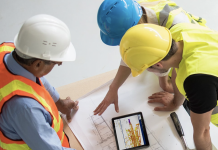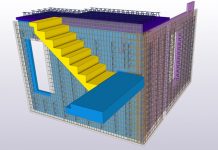Duncan Reed, Digital Construction Process Manager at Tekla (UK) Ltd, discusses the benefits of adopting BIM software modelling for planning and building control decision making
I suspect that by now, as we approach the milestone of 2016, you can’t fail to have heard about Building Information Modelling (BIM); the myriad definitions, the acronyms, levels, dimensions and maturity scales etc. etc. This is not helped by the fact that the definition of BIM is also something very hard to nail down too. In reality, the concept of BIM can be delivered in almost as many ways as there are projects – but before everyone throws their hands up in horror at this disruptive concept, it is worth remembering there are numerous common areas in all this new-fangled technology and processes. There are also many benefits and advantages of working with these digital processes for planners and building control officers.
But let’s start with the why bit first.
The Government Construction Strategy was published by the Cabinet office on 31 May 2011 and announced the government’s intention to require: collaborative 3D BIM (with all project and asset information, documentation and data being electronic) on its projects by 2016.
The background to this is the government’s four year programme for sector modernisation with the key objective of: reducing capital cost and the carbon burden from the construction and operation of the built environment by 20%. Central to these ambitions is the adoption of information data rich digital technologies, process and collaborative behaviours that will unlock new and more efficient ways of working at all stages of the project life-cycle.
This mandate for all centrally procured government contracts from 2016, means industry must meet the challenge – only through the implementation of BIM will we be able to deliver more sustainable buildings more quickly and more efficiently.
So essentially BIM is a process that uses the latest technology to create a shared knowledge resource of information about an asset. The key driver is transparency – linked to the ability to make better business decisions about the facility during its life-cycle, from earliest conception through to demolition. So it transcends past just the initial build phase and can be used to operate and maintain an infrastructure.
For local authority planning, this opens up lots of advantages. Compared to traditional hard copy drawings or documents, 3D images are much easier for everyone to understand – particularly non-construction professionals, who might struggle to interpret 2D drawings. By providing images, it is far easier for planning committees to understand the impact of a scheme and public consultation to be delivered in a far more meaningful way. It is also possible to explore the proposed building virtually, often using familiar devices such as electronic games controllers, and understand its context to the local environment.
Insight into intricate detail can easily be viewed and accessed, providing a much more detailed and realistic view of a building – inside and out. In fact, the use of technology, such as a drone, to take stills at different height levels of a structure, will give an accurate view from each floor of a building and allows planners to fully assess any implications in both the exterior and interior plans.
Taking this a few steps further, the development of 3D printing now means from the virtual model it is possible print physical 3D models to assist in the same way. This is quicker and cheaper than traditional model makers and truly brings a design to life.
Crucially though, a model allows a much greater degree of understanding and so can facilitate quicker decision making as the right data is stored, and more importantly accessible, about all aspects of the asset, whether at component, system or at a whole building level. Adopting these processes prevents the traditional loss of information associated with the hard handover of a project at design, procurement, construction and operation stages. By facilitating each group to add to and reference back to all information – as a single source of truth – a much richer, yet more efficient data set is available for decision making and management.
For building control, the use of a model, accessed by all parties to navigate around gives context to the complete design and can therefore assist in the overall approval process. (Interestingly, although early days, Singapore is attempting to move to a model based approval process across its planning and building control processes.)
To aid this process further, some software can actually check models for Building Regulation compliance, in areas such as Part B and Part M, prior to build commencing. Other products, like Tekla Structural Designer, can allow an engineer to check a model for structural compliance simply and easily, rather than having to wade through large PDF files of paper calculation sheets.
Finally, this approach also allows construction professionals to explore the model first to see if there is a problem, identify all the components that are situated in the suspect area complete with all the make, model, manufacturer and part number details, as well as any other information ever recorded in the past – so a complete catalogue of information at your fingertips that all parties can access to aid planning.
Ultimately, the aim of achieving the Government’s 2025 SMART vision of ‘An industry that is efficient and technologically advanced’, means that the industry must embrace the technological advancements across the board. This will be challenging, however the opportunities are vast; from reliable and accurate planning and forecasting, to projects built safely, on time and to budget. There are many companies embracing BIM and implementing the process across a variety of projects they are working on, but with the 2016 mandate looming, the race is on for this to be the norm.
Duncan Reed
Digital Construction Process Manager
Tekla (UK) Ltd
Tel: +44 113 887 9790











